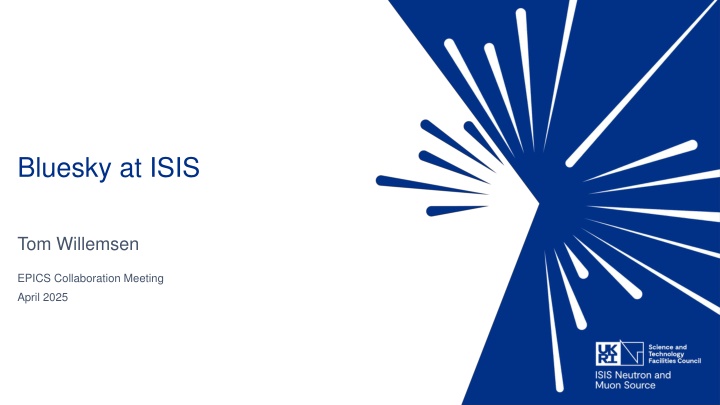
Neutron Scattering Techniques at ISIS: Collaboration and Innovation
Discover cutting-edge neutron scattering techniques at ISIS in collaboration with Bluesky. From EPICS collaboration meetings to advanced scanning processes, explore the latest developments in neutron and muon source technology, orchestration engines, and hardware abstraction layers. Learn about bluesky core libraries and initial use cases for small-angle neutron scattering and reflectometry beamline alignment, setting the stage for future innovations in neutron science.
Uploaded on | 6 Views
Download Presentation

Please find below an Image/Link to download the presentation.
The content on the website is provided AS IS for your information and personal use only. It may not be sold, licensed, or shared on other websites without obtaining consent from the author. If you encounter any issues during the download, it is possible that the publisher has removed the file from their server.
You are allowed to download the files provided on this website for personal or commercial use, subject to the condition that they are used lawfully. All files are the property of their respective owners.
The content on the website is provided AS IS for your information and personal use only. It may not be sold, licensed, or shared on other websites without obtaining consent from the author.
E N D
Presentation Transcript
Bluesky at ISIS Tom Willemsen EPICS Collaboration Meeting April 2025
Bluesky Mutli-facility collaboration "Experiment specification and orchestration engine" Scanning https://github.com/bluesky/governance
Scanning at ISIS Ad-hoc scanning scripts for each beamline
Scanning at ISIS for each beamline
Ophyd or ophyd-async? Hardware abstraction layer Ophyd Stable API Proven at several facilities Ophyd-async Active development - API not yet fully stable Fewer users PVAccess support asyncio concurrency On-site expertise (at Diamond Light Source) https://github.com/bluesky/ophyd-async
Core library ibex_bluesky_core Facility-specific bluesky plans, devices, callbacks Integrates with existing control system infrastructure Inspired by... dodal (Diamond Light Source) https://github.com/DiamondLightSource/dodal apstools (Advanced Photon Source) https://github.com/BCDA-APS/apstools https://github.com/isiscomputinggroup/ibex_bluesky_core
Small-angle neutron scattering (SANS) Coarse alignment (laser & optical diode) Variant of a bluesky ramp plan Able to run much faster than previous python scripts - more efficient CA usage Fine alignment (neutrons) Bluesky adaptive scan - reduces total required counting time Polarised SANS & spin-echo SANS System calibration / tuning Also relevant for polarised reflectometry Future work
Reflectometry Beamline alignment Scan, fit, check for each axis along beam path Bluesky LiveFit callback, weighting by uncertainties Plan specifies suitable fit models / constraints / checks / ranges for each axis Some components using bluesky adaptive scanning
Reflectometry Sample alignment Simultaneous sample height & detector angle alignment 2 bluesky LiveDispatchers produce two virtual scans from one physical scan 3x faster than previous approach, for comparable statistics
Muons Front-end beam steering optimisation Auto-tuning - comparable to reflectometers Zero-field compensation calibration Want to measure at B=0 Compensated for earth's magnetic field, stray fields from nearby magnets, remanence, ... Usage: magnetometers near sample position Calibration: additional magnetometers at sample position Model field at sample as a function of field near sample - find calibration factors by scanning Muon spin asymmetry optimization Future work
Muons ISIS accelerator produces double pulse of protons Also get double-pulse of muons Operating modes Both pulses to the same beamline Each pulse to a different beamline Scan over kicker timing Count on two beamlines simultaneously Find a region where just one of the pulses is "cleanly" kicked
Facility-specific challenges Data Acquisition Electronics Facility-specific detector hardware/software Many ways detectors can be run Histogram & event mode data Currently, not emitting full data into bluesky Scanning over detector-derived quantities Reduce data to a quantity of interest before it goes into bluesky events - using scipp Cf. xarray, pint, uncertainties, awkward-array
Facility-specific challenges Uncertainties Low count rates - counting errors are significant Propagation, fitting, plotting Currently implemented as pairs of bluesky signals with a naming convention Windows
Conclusion Minimal bluesky installations can be useful! Start simple, pick up extra components as-needed Tested successfully on a range of beamlines / use-cases Very positive feedback from scientists so far Now running "in production" Links https://github.com/bluesky/bluesky https://github.com/bluesky/ophyd-async https://github.com/isiscomputinggroup/ibex_bluesky_core

















